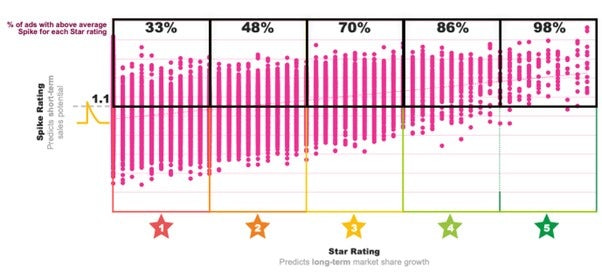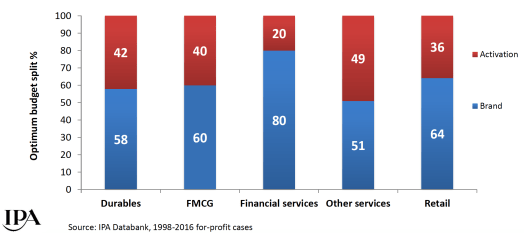I used to be obsessed with performance marketing.
As a digital planner, I was convinced that mass media was dead.
And I wasn’t the only one.
Just look at this chart.
What truly sucks, is that along the way we decided that performance marketing is different from traditional advertising.
In the last 20 years, the content we consume and the media we use have drastically changed.
That’s a fact.
But how communication and advertising work haven’t changed.
Thankfully, as much as data has supported the rise of highly targeted advertising, it’s also transformed our understanding of how advertising really works.
Marketing data combined with econometrics and consumer psychology have made it possible to see how advertising really works and how to measure its effect.
And Planning for Effectiveness is the foundation for delivering successful advertising campaigns.
What is Advertising Effectiveness, anyway?
I get that question a lot.
And it’s usually because marketers still use efficiency and effectiveness interchangeably.
They’re not the same.
Efficiency means spending fewer resources and effectiveness means getting greater results.
Think of it this way.
A petrol engine can convert only 4 out of every 10 litres of fuel into mechanical energy to move your car.
As much as 60% of the fuel you put in your tank is wasted as heat and exhaust.
On the other hand, in an Electric Vehicle over 77% of the electric energy stored in the battery is converted into mechanical energy at the wheels.
Both cars provide convenience.
And fueling one might be cheaper than the other.
But if you cared about cutting down on using fossil fuels AND saving money (outcome) then only one of them is a more effective option.
But only one of them is a more effective option if you cared for spending less on fuel.
Advertising effectiveness measures how successful your campaign was at delivering the desired commercial, brand, and behavioural effect.
Let’s be clear about one thing: Effectiveness is not a single metric.
And that can be a hard concept to grasp if you’re used to optimising your campaigns for CPC or ROAS.
Effectiveness measures how well your marketing is working over the long and the short term.
Effectiveness is a marketing function. It’s not a report.
And thanks to the work of brilliant marketers and researchers such as Dr. Grace Kite, Byron Sharp, Les Binet, Peter Fileds, Mark Ritson, and James Hurman, we can have the building blocks that make marketing an effective business function.
And in this 3-part series, I’ll give you a step-by-step walkthrough of advertising effectiveness. Starting with:
Planning for Effectiveness
Most marketers are familiar with the process of planning advertising campaigns.
- You start with deciding who you’re going to market to,
- what you’re going to say,
- how you’re going to use your budget, and
- what metrics you’ll use to measure success.
Planning for effectiveness follows the same process with the addition of 4 principles that have proven to drive commercial performance.
Principle #1 Set specific effectiveness targets for your campaign
The most important sign that your campaign is going to be successful isn’t your budget, it’s the work you put into setting a clear goal for it.
The IPA Database of 1400+ successful marketing campaigns starting from the 1980s have one thing in common:
They were planned around effectiveness targets.
Effectiveness targets are an umbrella term that includes your business, marketing, and campaign objectives for your campaign.

While most campaign planning processes start with some sort of a goal in mind, most get off track surprisingly quickly.
I recommend using Richard Rumelt’s ‘Kernel of Good Strategy’ framework to avoid that from happening to you.

Once you’re clear on what problem your campaign needs to solve, it becomes a lot easier to set effective targets for your campaign.

Principle #2 Spend more than your market share
Besides media selection and creativity, how much you spend on advertising is the single ‘biggest determinant’ of marketing success.
The good news is that you can calculate how much you need to spend for your campaign to be effective using the ESOV calculation.
ESOV stands for Extra Share of Voice. It’s the difference between your Share of Voice (your advertising budget) and Share of Market (your market share).

The rule of thumb says that keeping your media spend at least 10 points above your current market share can deliver between a 0.5% – 0.8% increase in your market share per year.
ESOV was introduced by Les Binet and Peter Fields in their 2010 book, The Long and the Short of it. Since then it’s proven to be a powerful tool for advertising effectiveness in multiple markets and categories.
For example, the ROI Genome Project found that if a similar-sized brand doubles its spending, an average brand in the same category with smaller spending can lose 15% of its business.

You wanna see some numbers, don’t you?
Let’s say your current market share is 10% and you want to increase it by 2% this year.
Following the ESOV method, your ideal advertising budget should be equal to 20 percentage points more than your current market share.
In other words, you need to have a 30% share of voice in your category.
With these numbers, if the total spend in the market is 10 000 000 € then your new marketing budget is going to be 3 000 000 €.
Side note #1: I use ESOV myself for setting target budgets.
It uses it to set benchmarks because actual market shares fall roughly around the actual SOV for different brands.
That’s why my advice is to build a model using 3 to 5 years of real data for your category.
And remember to factor in how your category is growing or shrinking in relation to the advertising activity.
Because since 2020, adspend in some categories has increased with increased demand in that category, while in others it’s decreased as the categories have shrunk.
Then there are other categories where increased competition is pushing the budgets ever higher.
As Dr. Grace advised: follow how your category is developing.
Side note #2: I’ve also seen smaller brands gain major lifts e.g. 0% to 3% in one year.
That’s usually done through aggressive distribution (physical availability), and price promotions.
So, you CAN grow with smaller advertising budgets.
But there are no free lunches.
What you’re not spending on advertising, you’re spending on buying shelf space and losing on price cuts.
Nothing wrong with that but worth keeping in mind.
Side note #3: Often market share gained through physical distribution doesn’t create long-lasting brand strength.
And it becomes unsustainable as the gains only last as long as you can sustain paying for distribution and discounts.
here are no shortcuts to building lasting commercial success.
And that’s why consistency is king.
Maintaining higher ESOV has a smaller effect over the short term (21% increase in growth over 1 – 2 years) and it grows over time (more than 40% over 3+ years).
And there’s a very good reason why maintaining ESOV is the bread and butter of planning for effectiveness.
Principle #3 Reach all buyers and non-buyers in your category.
For millennia advertisers have been trying to grab our attention.
Whether it’s the Medici’s branding themselves and their friends as Italy’s leaders in expensive frescos.
Or this engraved on the streets of Pompeii directing people to the establishment.
The rules of growth are straightforward:
- Drive more light buyers to your brand or
- Get the same buyers to buy more often.
As this study of 2,205 FMCG brands shows: brands that acquire new customers grow, while those that don’t shrink.
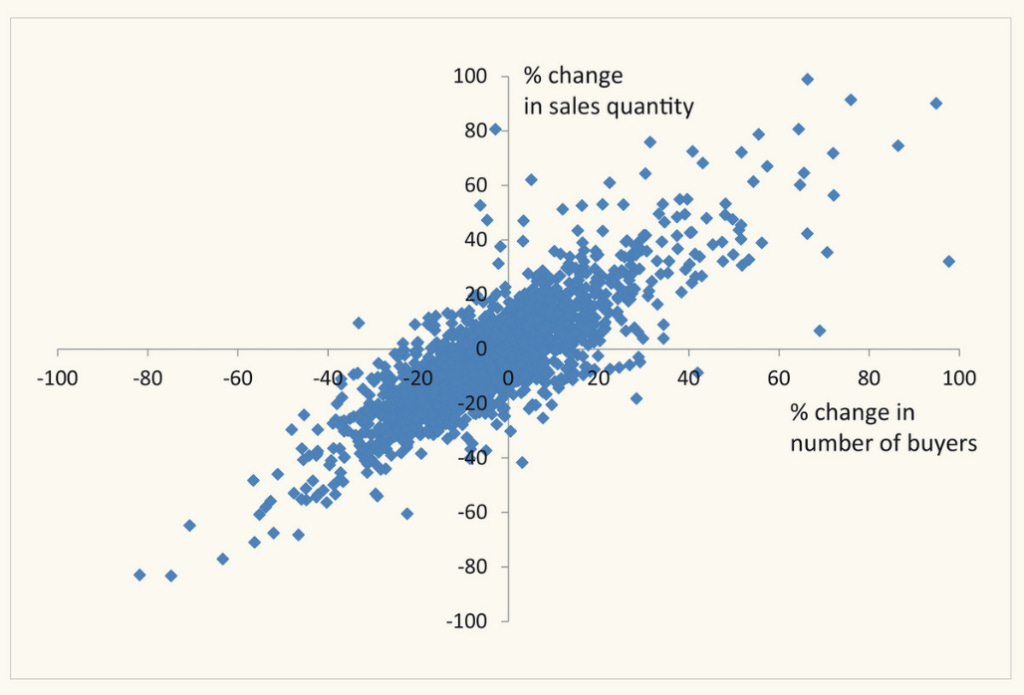
Building reach doesn’t mean advertising to everyone. It means building effective reach.
Effective Reach is a combination of two things:
- Exposure: ensuring that everyone in your target audience regardless of whether they’re buyers or non-buyers is exposed to your ad.
- Frequency: people exposed to the ad see it enough times for the ad to be effective.
I often start by segmenting my audience.
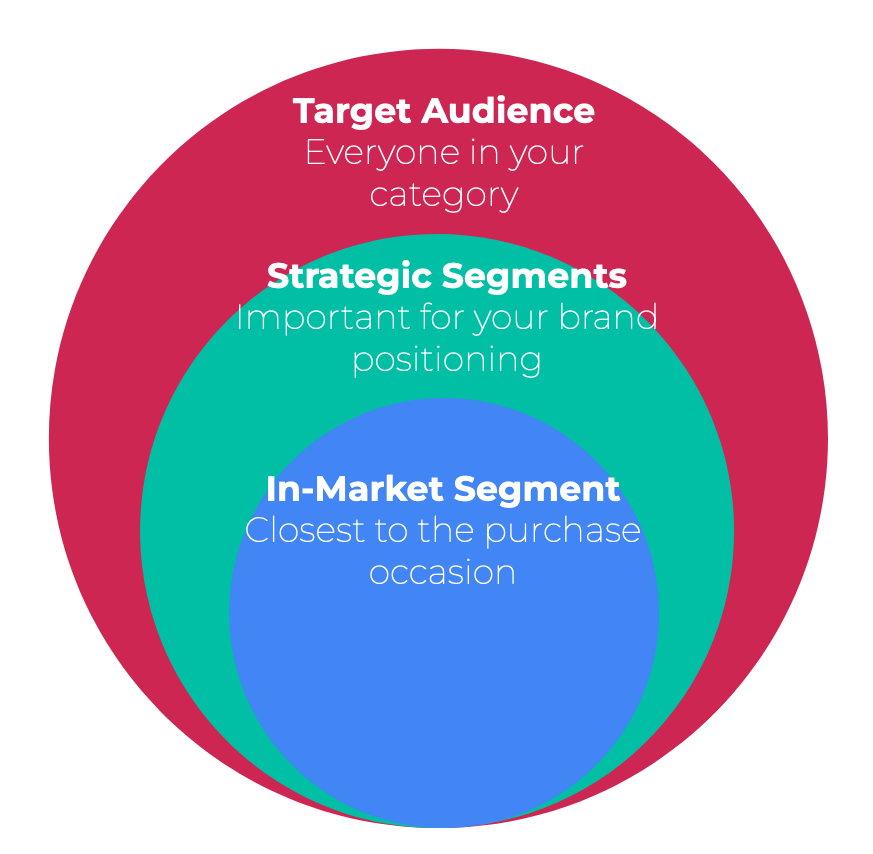
- Target Audience includes both buyers and non-buyers of your brand in your category. Pick media to reach everyone in your category at least once.
- Strategic Segment includes people among your target audience who are important for your brand position. Design your messaging for this segment. It may be the same as your Target Audience.
- In-Market audience is anyone in the target audience that’s the closest to the purchase occasion. Your advertising needs to budget them towards the brand.
You need to create and keep creating future demand.
People buy the idea of buying your brand before they open their wallets.
James Hurman calls it ‘future demand’.
Performance marketers call it Demand Generation and among the bro marketing community, it’s known as Revenue Engineering.
Take your pick as long as you’re becoming top-of-mind for people who will enter your category in the future, you’re on the right track.
Here’s why you need to create and keep creating future demand.
Categories grow by attracting more users
And as categories grow the brands within them grow as well.
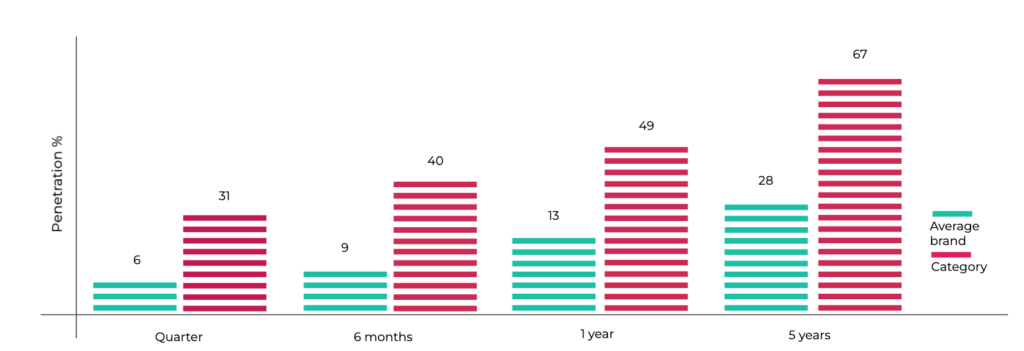
And since categories grow faster than any single brand in them, how much your brand will grow depends on your ability to reach and convince new customers.
This happens because:
- Most people buy more brands than one in a category (aka repertoire buying is the norm), and very few people are 100% loyal to a specific brand. Over an extended period, split loyalties reduce repeat purchases from one brand and contribute to growth for other brands.
- Brand penetration (% of people who buy your brand) remains constant, with the same customers switching between different brands, as long as the category remains unchanged.
Brands grow by reaching and convincing NEW customers as they enter the category.
And brands with a broader reach have an advantage over brands that don’t, because:
Brands with less market share have far fewer buyers (first jeopardy), and these buyers are slightly less brand loyal (second jeopardy).
Prof Byron Sharp calls it Double Jeopardy.
Since most people are repertoire buyers and brand penetration remains relatively steady, brands that reach more people in the category grow faster than brands that don’t.
And it’s proven to work in multiple markets and categories.
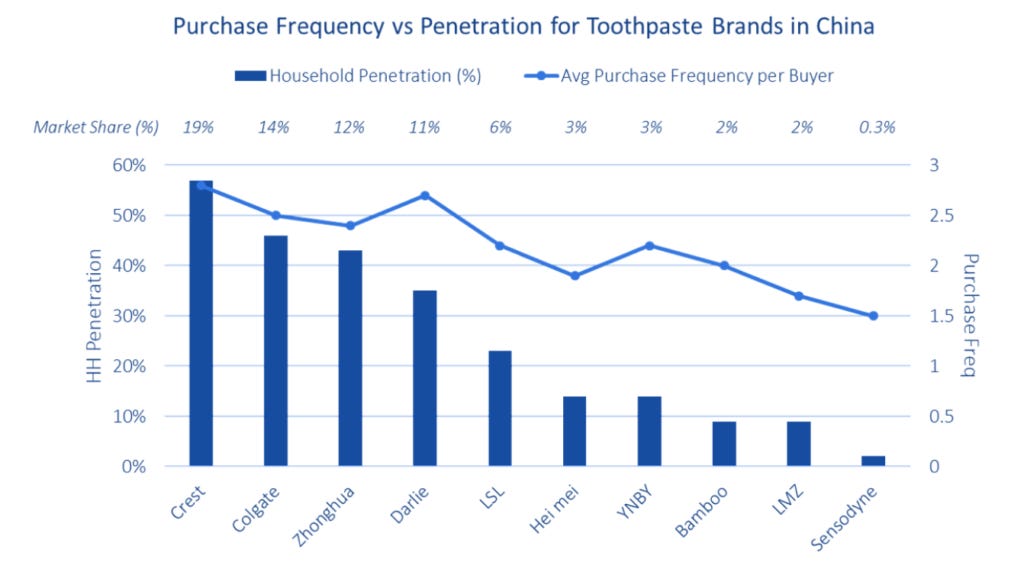
Reaching everyone in your category builds Mental Availability.
Availability Bias is a powerful tool because people don’t like trying new things.
Change creates cognitive load, so instead, we stick to information that comes to mind easily.
In advertising, we call it Salience or Mental Availability.
And making it easier for people to recognise and remember your brand makes it that much more likely to be picked and placed in the shopping cart.
Big brands are big because they’re recognised by a lot of people.
And that’s what keeps them top of mind – and keeps them growing.

Oh, and one more thing.
Reach is not a campaign objective or a KPI.
I don’t know who needs to hear this but it needs to be said.
Of course, your ads need to be seen for them to have any effect whatsoever.
It’s an essential first step. It’s not a goal.
How much of your target audience you’re able to reach and how often is essential to you reaching your campaign objective.
That’s why I include Reach and Frequency as a principle for planning an effective campaign.
It is not THE objective.
You can tell that I’m triggered by this. I so am.
So, thank you for listening to my rant.
Principle #4: Balance your ad-spend across brand and activation
Investment in brand advertising (Upper Funnel) campaigns outperform all other types of campaigns in the long run.
And this one gets overlooked. A lot!
The typical approach to budget planning is to have something for everyone.
It doesn’t work as well as we think.
Compromise leads to mediocrity.
And try as we might, the end result is too much of one thing or not enough of either.
Good thing we know that advertising that drives quick response (response marketing) doesn’t work well at creating future demand (brand marketing).
The latest data on this is only a couple of weeks old.
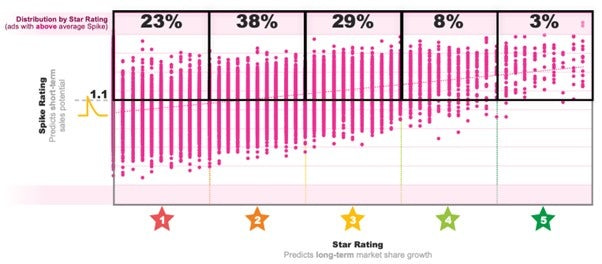
Thankfully, the answer isn’t more brand marketing.
It’s doing both properly.
And it’s much easier to do that once you’ve…
Earmarked separate budgets for brand and response.
Our starting point is Les Binet and Peter Field’s 60-40 Rule.
The rule says that a 60/40 split between brand and activation delivers the best effectiveness.
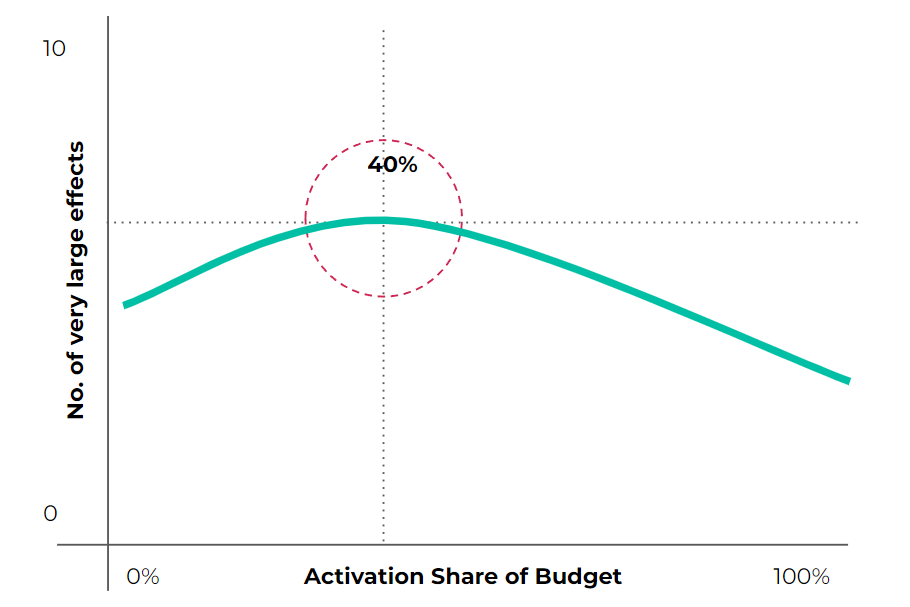
The idea behind this rule is simple:
Too much brand marketing and you miss out on capturing the demand you create. Too little and you fail at building Mental Availability – and future demand.
Since brand campaigns are the most effective at building future demand AND short-term sales, brand marketing gets the biggest share of the budget.
The 60-40 Rule changes by industry and category.
The actual split depends on your industry
or your category.
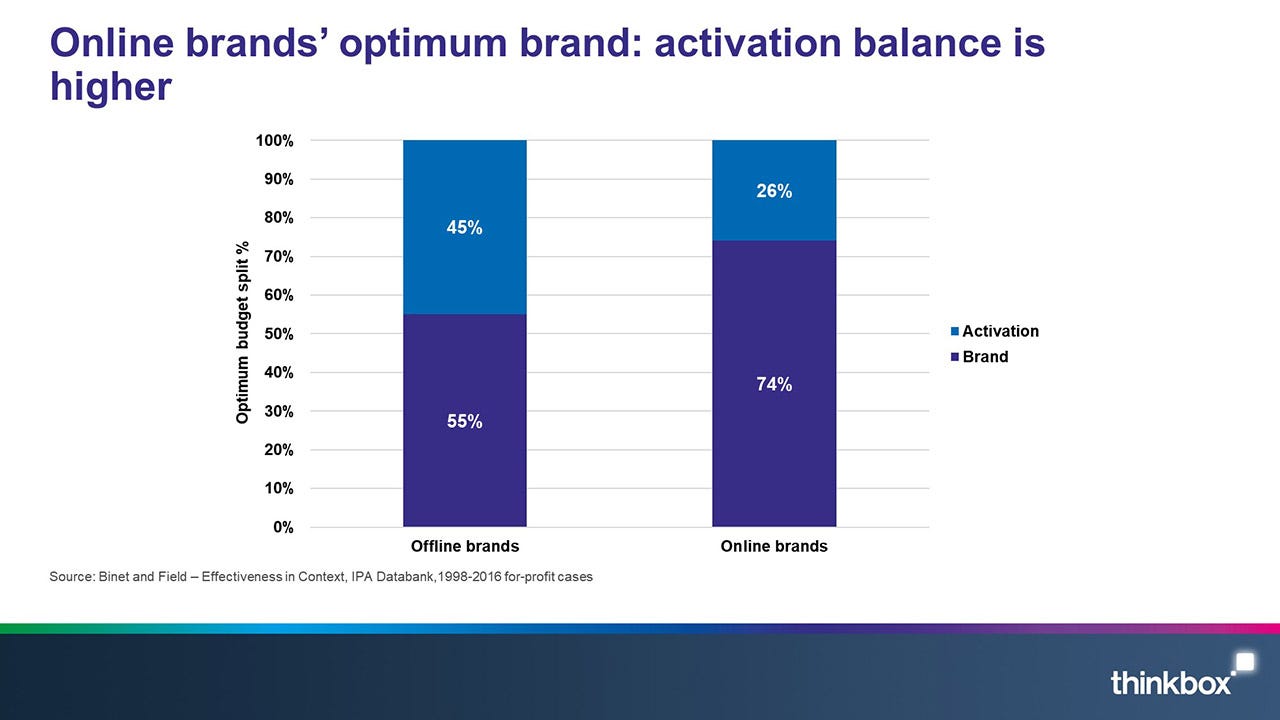
A great place to start is keeping an eye on how where competitors are investing.
After the budget comes channel selection.
Sidenote: Before going any further, let me say this. There’s no such thing as Brand vs Activation channels. It’s true that some channels are better at targeting and some deliver wider reach. But what a channel does for your campaign depends on your strategy. That’s why your advertising strategy MUST BE channel agnostic.
Effectiveness can improve by 2.6x when channel selection is based on campaign goals.
And going from one to two platforms can increase ROI by 19%.
But all channels aren’t created equal, Search and Social can build long-term ROI but they’re more effective at short-term activation.
On the other hand, TV and online video are more effective at driving long-term effects.
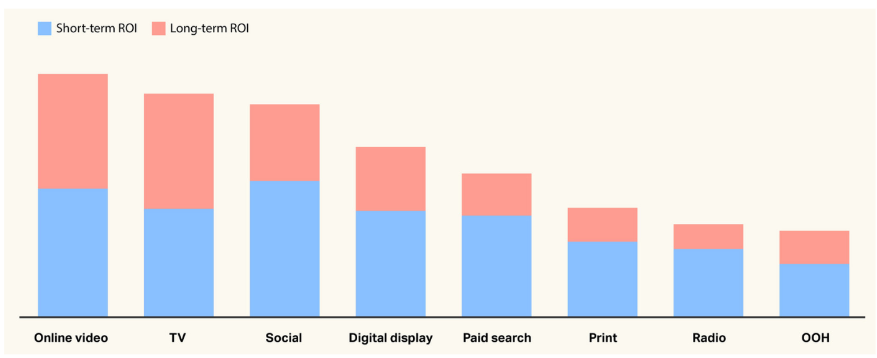
How well your budget split and channel selection works also depends on the duration of your campaign because:
Changes in pricing and volume occur over different timescales
This means that your advertising can get people to buy more (Volume effect) a lot quicker than it can successfully convince them to pay more (Pricing effect).
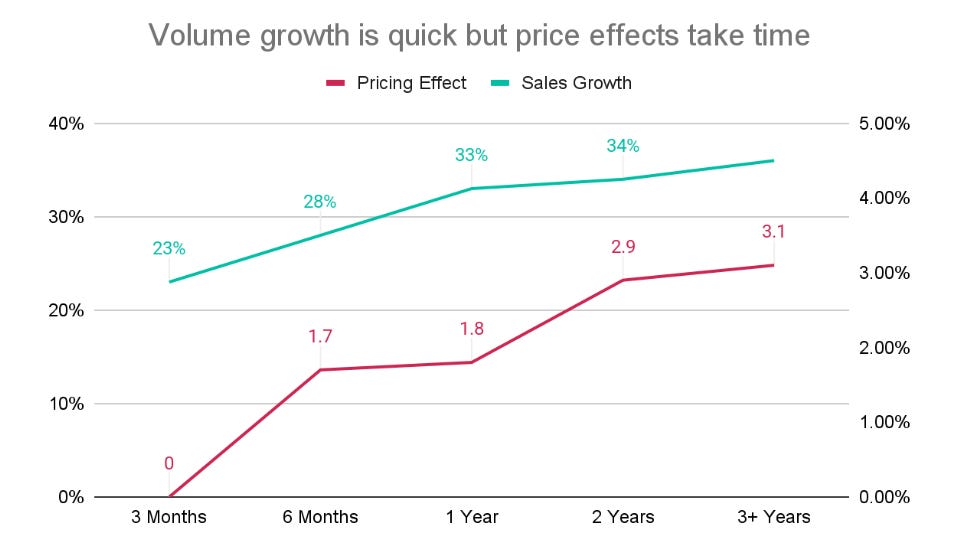
Pricing and volume effects occur over different timescales e.g. Short-term campaigns (3 months) don’t report major pricing effects.
And after 3 years the percentage of campaigns reporting strong price effects is still increasing.
And this difference in the time scale has a lot to do with budgeting.
Most of the time we end up investing more in activation because it seems to deliver results while investing in the brand doesn’t.
The mistake we’re making is looking at the wrong time scales.
The brand-building part of your budget should be evaluated over a period of at least 6 months.
And you can keep measuring the activation elements over 12 weeks.
That sums up the 4 basic principles for planning effective advertising campaigns.
I really love the quote below but it didn’t quite fit in neatly with any of the principles.
But I think it does a great job reminding us what effective advertising is all about.
The most important metrics to look at first are financial and business metrics… If you got a strong brand, you will see it in the financials. If you’ve got a weak one, you’ll see it in the financials.
Les Binet
Here’s a link to the 4 principles.
- Set clear and specific targets for your advertising campaigns: The most important sign that your campaign is going to be successful is not your budget, it’s the work you put into setting specific goals for your campaign.
- Spend more than your current market share: Besides media selection and creativity your advertising spend relative to your competitors is a key driver of brand growth.
- Reach everyone in your category: Advertising campaigns that drive more light category buyers to your brand or successfully get them to buy more often are more effective at growing your brand than campaigns only targeted towards a narrow group of heavy buyers.
- Balance your ad spend across branding and activation: The rule of thumb suggests a 60/40 split in the favour of your brand. Even though the ratio differs by industry, investments in upper funnel campaigns outperform all other types of campaigns in the long run.
Further Reading & Sources
- WARC: https://www.warc.com/newsandopinion/opinion/les-binet-on-why-long-term-marketing-matters-in-the-age-of-short-termism/en-gb/3307
- Robert Brittain & Peter Fields, ‘ To ESOV and Beyond’ – Advertising Council Australia, 2021
- Binet & Field, The Long and the Short of it, 2010
- WARC Anatomy of Effectiveness
- How Brands Grow, Sharp and Romaniuk
- Decoding Decisions, 2020, Google
- Kantar: https://www.kantar.com/inspiration/brands/to-grow-brands-must-invest-across-the-buyer-lifecycle
- Kantar: https://www.kantar.com/inspiration/brands/brands-need-to-build-more-than-just-salience-to-grow
- Quantifying the Target Market, Wiley



